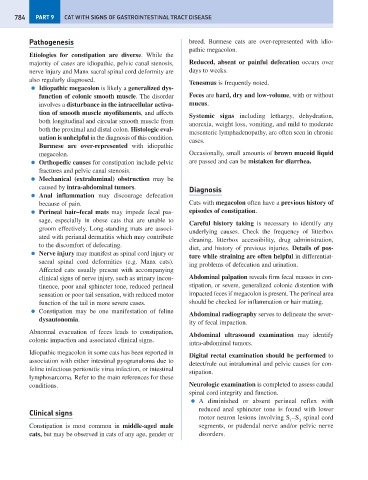Page 792 - Problem-Based Feline Medicine
P. 792
784 PART 9 CAT WITH SIGNS OF GASTROINTESTINAL TRACT DISEASE
Pathogenesis breed. Burmese cats are over-represented with idio-
pathic megacolon.
Etiologies for constipation are diverse. While the
majority of cases are idiopathic, pelvic canal stenosis, Reduced, absent or painful defecation occurs over
nerve injury and Manx sacral spinal cord deformity are days to weeks.
also regularly diagnosed.
Tenesmus is frequently noted.
● Idiopathic megacolon is likely a generalized dys-
function of colonic smooth muscle. The disorder Feces are hard, dry and low-volume, with or without
involves a disturbance in the intracellular activa- mucus.
tion of smooth muscle myofilaments, and affects
Systemic signs including lethargy, dehydration,
both longitudinal and circular smooth muscle from
anorexia, weight loss, vomiting, and mild to moderate
both the proximal and distal colon. Histologic eval-
mesenteric lymphadenopathy, are often seen in chronic
uation is unhelpful in the diagnosis of this condition.
cases.
Burmese are over-represented with idiopathic
megacolon. Occasionally, small amounts of brown mucoid liquid
● Orthopedic causes for constipation include pelvic are passed and can be mistaken for diarrhea.
fractures and pelvic canal stenosis.
● Mechanical (extraluminal) obstruction may be
caused by intra-abdominal tumors. Diagnosis
● Anal inflammation may discourage defecation
because of pain. Cats with megacolon often have a previous history of
● Perineal hair–fecal mats may impede fecal pas- episodes of constipation.
sage, especially in obese cats that are unable to
Careful history taking is necessary to identify any
groom effectively. Long-standing mats are associ-
underlying causes. Check the frequency of litterbox
ated with perianal dermatitis which may contribute
cleaning, litterbox accessibility, drug administration,
to the discomfort of defecating.
diet, and history of previous injuries. Details of pos-
● Nerve injury may manifest as spinal cord injury or
ture while straining are often helpful in differentiat-
sacral spinal cord deformities (e.g. Manx cats).
ing problems of defecation and urination.
Affected cats usually present with accompanying
clinical signs of nerve injury, such as urinary incon- Abdominal palpation reveals firm fecal masses in con-
tinence, poor anal sphincter tone, reduced perineal stipation, or severe, generalized colonic distention with
sensation or poor tail sensation, with reduced motor impacted feces if megacolon is present. The perineal area
function of the tail in more severe cases. should be checked for inflammation or hair matting.
● Constipation may be one manifestation of feline
Abdominal radiography serves to delineate the sever-
dysautonomia.
ity of fecal impaction.
Abnormal evacuation of feces leads to constipation,
Abdominal ultrasound examination may identify
colonic impaction and associated clinical signs.
intra-abdominal tumors.
Idiopathic megacolon in some cats has been reported in
Digital rectal examination should be performed to
association with either intestinal pyogranuloma due to
detect/rule out intraluminal and pelvic causes for con-
feline infectious peritonitis virus infection, or intestinal
stipation.
lymphosarcoma. Refer to the main references for these
conditions. Neurologic examination is completed to assess caudal
spinal cord integrity and function.
● A diminished or absent perineal reflex with
reduced anal sphincter tone is found with lower
Clinical signs
motor neuron lesions involving S –S spinal cord
1 3
Constipation is most common in middle-aged male segments, or pudendal nerve and/or pelvic nerve
cats, but may be observed in cats of any age, gender or disorders.

